Swimming is an ideal low-impact cardiovascular workout that burns high calories, builds stamina and endurance and uses all the major muscles in your body (upper and lower). Swimming can be more intense than running, if the strokes are performed correctly and at the right intensity.

Swimming is a full body workout and the major muscles help power you through the water, helping with strength as well as calorie burning. It can be a fun activity to attend with friends or perfect for going alone and relaxing. It has been proven to help you unwind, relieve stress and even minimise symptoms of depression. It does not cost a lot to go swimming, as all you essentially need is a swimming costume/trunks, and possibly goggles and hat, plus the fee to a local swimming pool.
Swimming is gentle on your joints and perfect for people who have weak bones or are recovering from injury. Due to the buoyancy in the water, you can perform intense exercise without feeling pain … although your muscles may feel it the following day!
There are many strokes to choose from when swimming, which helps keep it a varied exercise, and each stroke uses different muscles and has individual benefits. If you use a mixture of strokes, you are more likely to work the whole body and see more results, as well as balance your muscle groups.
Swimming Techniques
It is crucial to master good swim strokes, form and technique, especially if you are a novice. It may be worth investing in a few lessons to refresh your memory or asking a swimming instructor or friend to watch you swim and help you improve your form. If your breathing technique or stroke is wrong, it can hinder your exercise regime and tire certain muscles out unnecessarily.
If your muscles are fatigued early on, it can hinder your whole swimming session. Although swimming is easy on your joints and great for rehabilitation, it is strenuous exercise for your muscle groups.
Here are some of the most popular swimming strokes and their benefits:
Front Crawl or Freestyle
Works: core, hips, legs
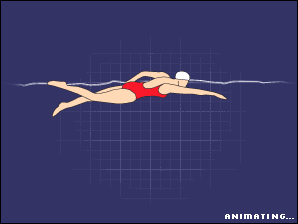
The front crawl is a fast stroke which focuses on your core. Good breathing technique is important for this stroke, as you need to swim close to the surface of the water with your head immersed, until you tilt to the side for breath. It involves kicking quickly to propel through the water and lifting your arms in and out of the water in fast strokes, with your body straight.
A lot of the movement comes from your core muscles, which really benefits you if you get this technique correct. Front crawl is the most streamlined stroke for your body and helps your glide through the water quicker than others, causing less splash and more speed and lots of power from your hips. Front crawl will burn more calories than backstroke when swum at the same intensity. Whereas front crawl works your upper back and lats, breaststroke uses the pecs, so for a balance it is best to combine strokes.
Breaststroke
Works: biceps, triceps, legs, pectorals, shoulders, back, glutes, inner, outer thighs
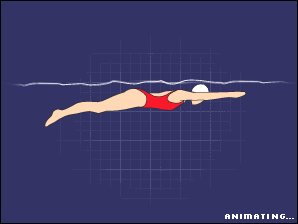
Breaststroke is a fairly gently stroke and an especially good choice for beginners. It works your whole body but is much slower and gentler than front crawl. If performed correctly, the breaststroke will work out your arm muscles (biceps and triceps), pectorals, shoulders, back, glutes and major leg muscles.
To perform the stroke efficiently, you must perfect the breathing involved, which also improves lung capacity and helps you glide through the water better. Many women opt for breaststroke, especially for toning the “difficult areas” such as the inner and outer thighs and glutes.
Butterfly
Works: arms, shoulders, back
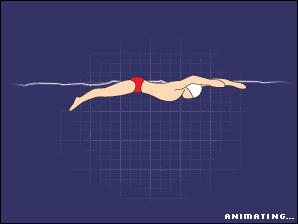
Of all the strikes, the butterfly is the best for burning calories and building muscles. It can burn up to 900 calories an hour. Although an hour of the butterfly stroke would be very heavy going and leave you incredibly sore the next day! Muscular power is needed to move your body in and out of the water in the butterfly stroke and it involves short, burst of power and movement to get you from one side to another. It is also one of the most difficult strokes to master and is vigorous on your body, which may lead to early fatigue, especially if you haven’t mastered the technique properly.
Back Crawl
Works: arms, legs. core
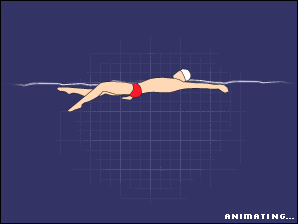
This can be a fast and easy stroke to master. Lying on your back, kick your legs and propel your arms. It is particularly useful for those who find underwater swimming and breathing difficult, as it does not involve putting your face into the water. It works the major muscles in your arms and legs, while strengthening your core muscles that help keep you flat along the water’s surface.
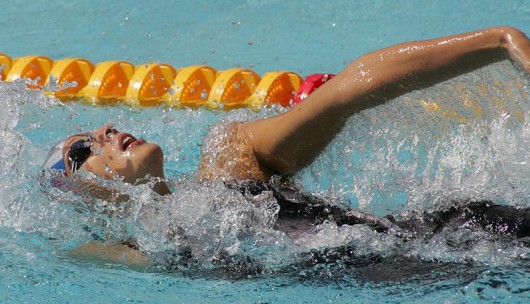
For general cardio workouts, it is worthwhile introducing swimming into your routine, perhaps at a comfortable intensity for 2 or 3 times a week and 30-45 minute sessions. If you are working to improve your endurance and strength, as well as losing weight, introduce some high intensity interval training into your sessions (few minutes of very fast swimming, followed by slower minutes to recover), and incorporate some rest days. Although it may not feel like it at the time, swimming is a heavy workout for your body and muscles and you will need time to recover.
Swimming works well with other forms of exercise, as it is so different and can really mix up your regime and stop boredom setting in as this is one of the reasons why people quit fitness. Many people use swimming as a form of therapy, as it can be relaxing and ease symptoms such as stress and anxiety.
Water has soothing and healing qualities and it’s great for your wellbeing. The strokes allow you to stretch the muscles in your body without the impact and feelings you’d get if you were exercising on dry land, but you can still be safe in the knowledge that you are giving your body a great, all over workout.
Find out what is the best cardio exercise that gets you the most bang for the buck.



